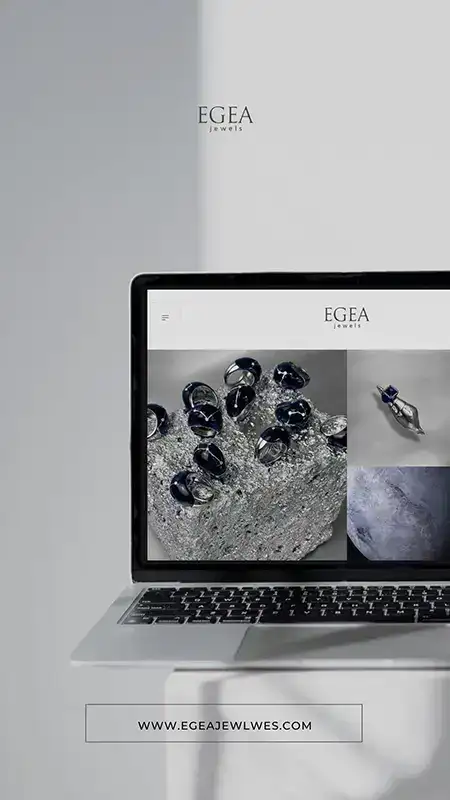Information architecture
EGEA jewels
Jewelry Branding and E-commerce Strategy for Emerging Luxury Brands

Overview
Deliverables
· Ecommerce audit (UX, SEO, brand tone)
· Information architecture
· Category clustering for semantic SEO
· UX copywriting & interface microcopy
· SEO content hierarchy (EN/IT)
· Homepage narrative redesign
· Brand tone harmonization across catalog
· Performance and analytics setup
THE CHALLENGE
EGEA Jewels had all the ingredients of a premium brand: handcrafted design, unique symbolism, and Italian heritage.
But EGEA’s ecommerce felt like a spare-parts archive and was telling a very different story: product-first, experience-last.
Hundreds of product pages were piled with no hierarchy, no emotional lead-in, no grouping logic. Rings and pendants were listed like hardware components, stripped of soul and sequence.
The interface was purely functional:
– No chromatic identity
– No collection logic
– No curated entry points for browsing or storytelling
Our starting point?
Making a fragmented database into a living system of meaning where the product architecture, color palette, and tone of voice work as one.
STRATEGIC INSIGHT
In high-end jewelry, every click is a gesture of trust. Our goal was clear: bring structure, clarity, and meaning to a brand that needed a full-service jewelry ecommerce strategy.
But without semantic clarity (for Google) and emotional rhythm (for users), even the most stunning pieces get treated like catalog fillers.
As a branding agency for handmade jewelry, our goal wasn’t to push products but to design, develop, and choreograph the right journey: for the dreamer, the gifter, the collector.





Why Information Architecture Is the Secret Weapon of High-Converting Websites
1. What Is Information Architecture and Why It Matters
In today’s hyperconnected world, getting traffic to your website is only half the battle. The real challenge begins once users land on your site. Will they find what they’re looking for quickly? Will they enjoy the experience enough to stay—or better yet, convert? This is where the often-overlooked discipline of information architecture becomes crucial.
Information architecture refers to the practice of organizing, structuring, and labeling content in a way that makes it easy for users to navigate and find what they need. Think of it as the blueprint of your website—the framework that supports both usability and findability. Without solid information architecture, even the most beautiful website can feel like a maze, frustrating users and driving potential customers away.
By applying the principles of information architecture, you’re not just designing a website—you’re designing a guided experience. A well-thought-out site map, intuitive categorization, and logical content flow help ensure that visitors don’t have to think too hard. The easier it is to browse your site, the more likely users are to trust your brand and engage with your content.
2. From Confusion to Conversion: How Information Architecture Boosts Business
A common mistake businesses make is focusing too much on aesthetics or keyword stuffing, while neglecting how users actually move through the site. This is a critical oversight. Traffic is meaningless if users get lost, annoyed, or overwhelmed. Conversions happen when users feel confident and in control—and information architecture is what gives them that power.
Let’s say a user lands on your homepage through a Google search. They’re interested in your services, but they can’t immediately locate them on the site. Maybe they get distracted by irrelevant content or confused by an unclear menu. Within seconds, they bounce. That’s a lost conversion—and it could’ve been avoided with smarter information architecture.
Good information architecture acts like a silent concierge, helping users move effortlessly from entry point to action. It makes the call-to-actions (CTAs) more visible, the content more digestible, and the journey more logical. Whether you’re running an e-commerce platform or a B2B service site, structuring your content and navigation with user intent in mind leads directly to higher engagement and better ROI.
3. Building Trust and Delight Through Seamless Navigation
Users form opinions about a website within milliseconds. If they feel disoriented or overwhelmed, trust diminishes. On the other hand, when a site “just makes sense,” it creates a sense of professionalism, clarity, and credibility. That’s the magic of well-executed information architecture—it makes the experience feel effortless, even delightful.
Beyond just helping users find what they need, information architecture has a psychological impact. It reduces cognitive load, instills confidence, and encourages deeper exploration. When users feel like the site understands them, they’re more likely to complete desired actions—whether it’s making a purchase, signing up for a newsletter, or booking a consultation.
In essence, information architecture is about empathy. It's the difference between a pushy salesperson and a helpful guide. It respects the user's time, anticipates their needs, and creates a journey that feels natural and rewarding.
Conclusion
Don’t let your website be a beautiful shell with no internal compass. The success of your digital presence relies not just on how many people visit, but on how effectively they move through your site—and how satisfied they feel when they do. By investing in information architecture, you're not just organizing content; you're designing trust, guiding attention, and setting the stage for conversion.
Want to make your site work harder for your brand? Start with smarter information architecture—because structure isn’t boring, it’s everything.

